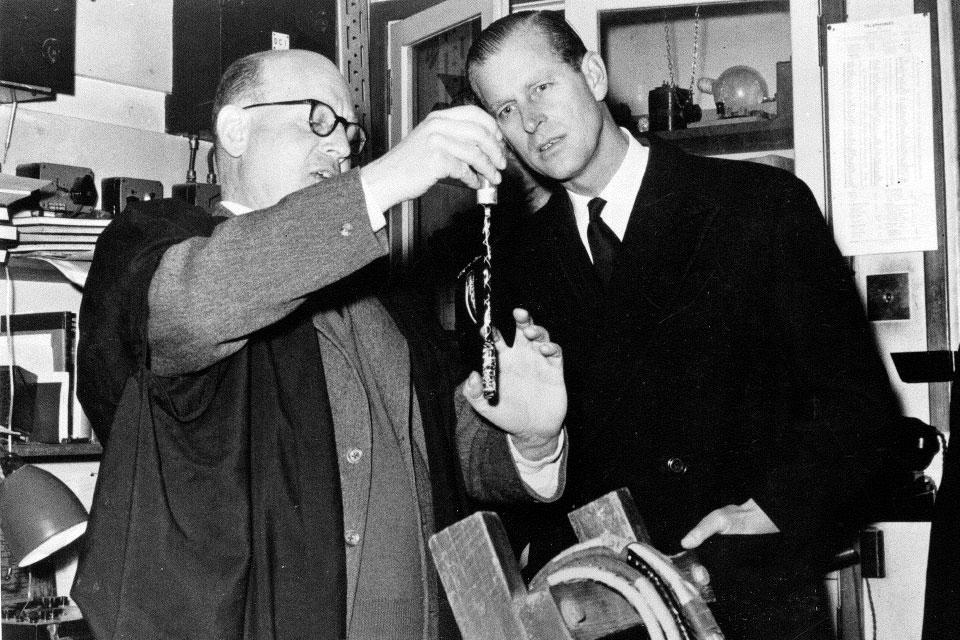As Buckingham Palace today announces the death of Prince Philip aged 99, our archivist, Professor Stephen Blundell describes a recorded visit to the Department of Physics on 4 November 1960.
‘The Clarendon archive contains several documents describing the detailed arrangements for Prince Philip’s visit to the Department of Physics, part of an Oxford day out for the Queen and Duke of Edinburgh, and in reading them one gets the sense of a different age, where protocol and deference were very much the order of the day.
A visit fit for a prince
‘The royal couple arrived by train and were welcomed first in the town hall and then at Christchurch, before being sped to Broad Street. At the bottom of the steps of the Clarendon building, opposite Blackwells, they were greeted by the newly appointed Chancellor (Harold Macmillan), then presented to the Proctors at the top of the steps, followed by the Vice-Chancellor (A.L.P. Norrington, of "table" fame) and the Registrar (the wonderfully-named Sir Folliott Sandford) along the corridor towards the Bodleian. After a ceremony in the Sheldonian (where God save the Queen was heartily sung and the Public Orator orated) it was time for lunch in Trinity, after which the royal party was whisked to Holywell great meadow. Here the Duke inspected a parade of the cadet force and viewed an architect’s model of a planned new college (St Catherine’s). Now there was a parting of the ways: the Queen travelled on to Lady Margaret Hall while the Duke came to the Clarendon, for a visit scheduled strictly between 3.20 p.m. and 3.50 p.m. The instructions were unambiguous: the physicists should not get carried away and waylay the Duke; he was required to accompany the Queen for a 4 p.m. tea at St Anne’s before returning to Windsor and she was not to be kept waiting.
‘The files show that in the preparations for Prince Philip’s visit, the physicists were concerned about two important matters. Should a flag be flown at the lab during the Duke’s visit? If so, could the University supply a flag? The flagpole could be constructed in the Clarendon workshop. And would the press accompany the Duke? The physicists were concerned that the Clarendon’s narrow corridors, if clogged with waiting reporters and photographers, would impede the procession of the royal party. However, the University insisted that the press attended. In the event, Professors Bleaney and Wilkinson accompanied the Duke on his tour, while Mr Keeley (the lab administrator) shepherded the reporters and presumably ensured that they wouldn’t get in the way.
Stellar line-up
‘The Duke was taken first to Brebis Bleaney’s office, where he was presented to Bleaney, Denys Wilkinson, Mr Keeley and Drs Brewer (atmospheric physics), ter Haar (theoretical physics) and Mendelssohn (low-temperature physics). The Duke was then invited to admire another architect’s model, this time of the shortly-to-be-built Keble triangle laboratory (now known as the Denys Wilkinson Building). He was then taken to Nicholas Kurti’s lab (as shown in the photograph), the main workshop and finally to Dr Kuhn (for some reason the atomic physicist was positioned at the foot of the main stairs) before finally being allowed to leave.
‘The files do not reveal what Prince Philip made of any of this. They do however show that, in advance of the visit, Professor Bleaney sent a note around to the Department in which he informed everyone: 'The Duke’s route inside will be:- Front door to Professor Bleaney's room, then downstairs and into High Tension room; thence to basement (north side), to synchrotron and back through "techniques room", through yard to helium liquefier room, then past "Green hut" and side door into Simon Building, returning through the main workshop to Spectroscopy and out by Front Door.' He added the following stern instruction: 'The route must be kept clear of all matter, animate and inanimate, and rooms on the way occupied only by their legitimate users.''

